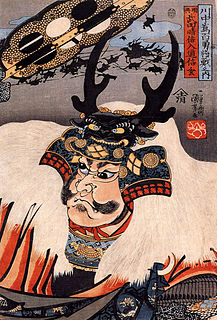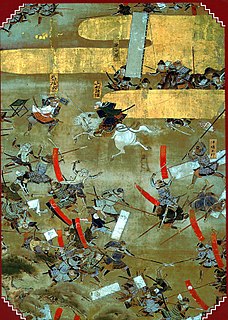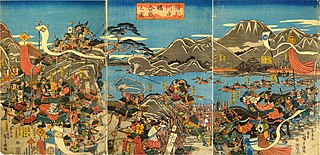
The battles of Kawanakajima were fought in the Sengoku period of Japan between Takeda Shingen of Kai Province and Uesugi Kenshin of Echigo Province in the plain of Kawanakajima, Nagano, "the island between the rivers", in the north of Shinano Province. The location is in the southern part of the present-day city of Nagano. Five major battles took place there: Fuse in 1553, Saigawa in 1555, Uenohara in 1557, Hachimanbara in 1561, and Shiozaki in 1564. The best known and most severe among them was fought on October 18, 1561, and was only fought in the heart of the Kawanakajima plain, thus being the "battle of Kawanakajima". The battles were fought after Shingen conquered Shinano, expelling Ogasawara Nagatoki and Murakami Yoshikiyo, who subsequently turned to Kenshin for help. The battles became one of the most cherished tales in Japanese military history, the epitome of Japanese chivalry and romance, mentioned in epic literature, woodblock printing and movies.

Sanada Masayuki was a Japanese Sengoku period lord and daimyō. He was the head of Sanada clan, a regional house of Shinano Province, which became a vassal of the Takeda clan of Kai Province.

Itagaki Nobukata was a retainer of the Takeda family. His name is also seen with different kanji as 信形.
Ogasawara Nagatoki (小笠原長時) was a Japanese samurai daimyō of Shinano Province in the Sengoku period.
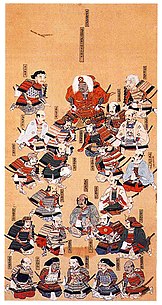
The Twenty-Four Generals were just one of many historically famous groupings of battle commanders from Japan's Sengoku Period. These Twenty-Four were the most trusted companions of Takeda Shingen. A third of them died at the famous Battle of Nagashino in 1575 when they led the Takeda forces against Oda Nobunaga. When Takeda Katsuyori committed suicide in 1582, declaring the end of the Takeda clan, only three of them were still serving under the Takeda.
The Battle of Sezawa was one of many battles fought by Takeda Shingen in his bid to take control of Shinano Province during the Sengoku Period of Japan.
The siege of Uehara was the first of many steps taken by Takeda Shingen in his bid to seize control of Shinano Province. Uehara Castle had been controlled by Suwa Yorishige before it was taken by Shingen.
The siege of Fukuyo was the one of many steps taken by Takeda Shingen in his bid to seize control of Shinano Province. The fortress at Fukuyo lay in the Ina valley, south of Lake Suwa. Tozawa Yorichika, an ally of Takatō Yoritsugu, lord of Takatō castle, surrendered quickly. The Battle of Ankokuji followed the siege.
The Siege of Nagakubo (長窪城) was a battle of Japan's Sengoku period. It took place in 1543 as part of Takeda Shingen's bid to control Shinano Province, Japan. He took the castle of his former ally, Oi Sadataka, who had deserted him to ally with Murakami Yoshikiyo. Oi was sent to Takeda's home city of Kōfu as a prisoner, where he was then killed.
The 1545 siege of Ryūgasaki was one of many battles fought by Takeda Shingen in his bid to control Shinano Province during Japan's Sengoku period. The fortress was a satellite castle of Fukuyo,The fortress was held by Tozawa retainer Yoshinaga Mitoyoshi.Yoshinaga himself was killed in battle while the fortress fell.
Sanada Nobutsuna was a Japanese samurai of the Sengoku period. He was born in Matsuo castle and was the eldest son of Sanada Yukitaka, a castle lord in Shinano Province who, by the time of his son's coming-of-age, had pledged his loyalty to the Takeda. During his coming-of-age ceremony, therefore, Sanada Nobutsuna was granted the shin (信) character from Takeda Shingen's name and took the name of Nobutsuna (信綱).
The 1546 siege of Uchiyama was simply one of many battles fought in Takeda Shingen's bid to gain control of Shinano Province. His troops surrounded the fortress and starved out the garrison.
The 1548 battle of Shiojiritoge was one of many battles fought by Takeda Shingen in his bid to conquer Japan's Shinano Province. It took place soon after Shingen suffered a devastating loss in the battle of Uedahara; he sought revenge, and to return to a string of victories.
The siege of Shika castle, spanning the years 1546 to 1547, was one of many battles fought in Takeda Shingen's bid to seize control of Shinano Province. Having just defeated Uesugi Norimasa at the battle of Odaihara, Shingen made use of 300 severed heads obtained at that battle to intimidate Shika's garrison. He displayed the heads prominently outside the besieged castle until Kasahara Kiyoshige surrendered.
The 1546 Battle of Odaihara was one of many steps taken by Takeda Shingen, one of Japan's great warlords of the Sengoku period of Japan, in his bid to take over Shinano province. He met the forces of Uesugi Norimasa on the plains of Odaihara, and defeated Uesugi's army while devoting a portion of his own force to the concurrent siege of nearby Shika castle. His victory at Odaihara would grant him hundreds of enemy heads to use for intimidation tactics at Shika.
The 1553 siege of Katsurao was one of many sieges undertaken by the warlord Takeda Shingen in his bid to gain control of Japan's Shinano province. He successfully took the fortress from Murakami Yoshikiyo, and seized three more minor fortresses over the next four months, at Wada, Takashima and Fukuda.
The 1554 siege of Kiso-Fukushima was a siege by Takeda Shingen on Fukushima Castle, in the Kiso River Valley of Shinano province. This was one of many battles fought during Shingen's campaign to seize control of Shinano.
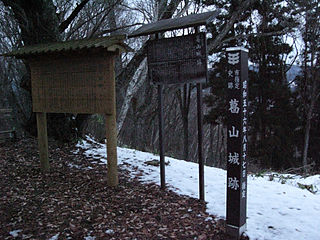
The Siege of Katsurayama in March 1557 was fought between the forces of the Japanese daimyō Takeda Shingen and Uesugi Kenshin as part of the Kawanakajima campaigns. Katsurayama castle was a strategically vital Uesugi stronghold in the contested Shinano Province and, when it was isolated from reinforcements due to late snow in early 1557, the Takeda clan used this opportunity to attack it. Although the castle garrison, consisting of the Ochiai clan and elements of the Murakami clan, defended Katsurayama furiously, the Takeda forces under Baba Nobuharu eventually stormed into the castle. Most of the garrison was killed in combat, while the families of the defenders committed mass suicide and the castle was burned to the ground.
